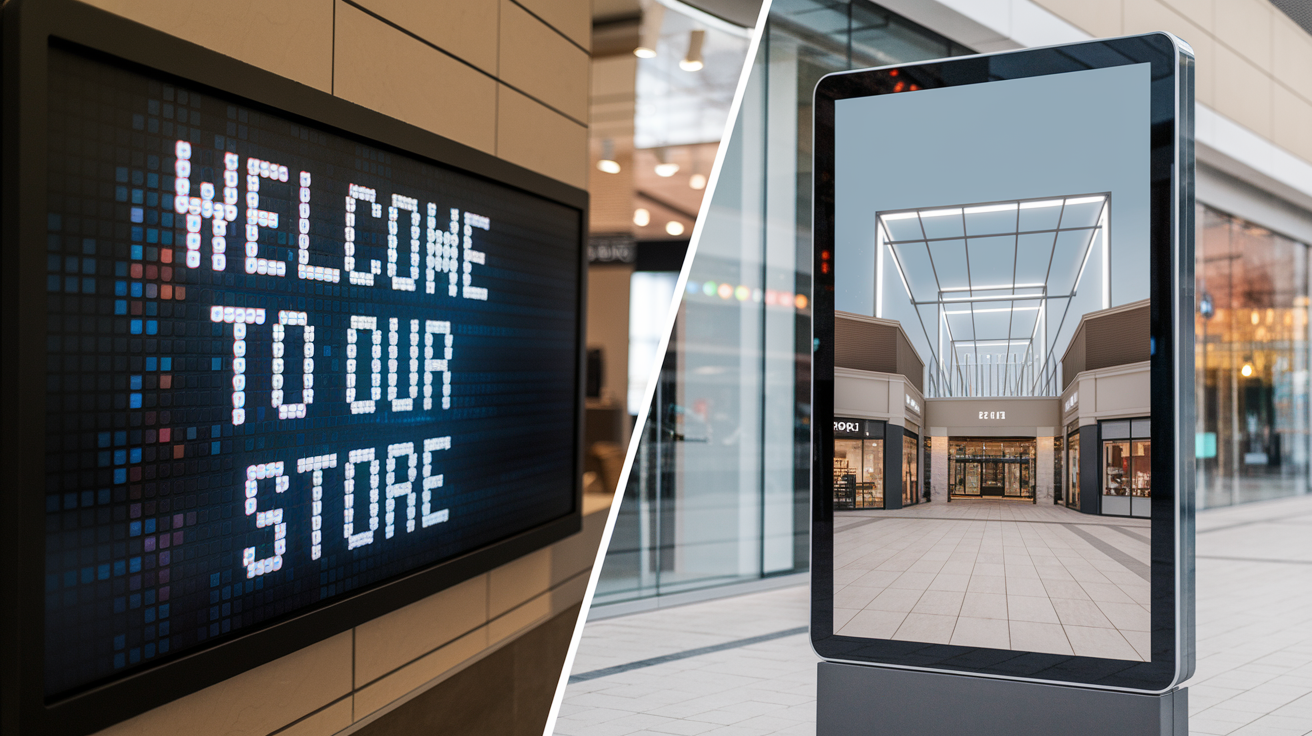What Are the Different Types of Signage?
Signage encompasses a wide range of visual displays, from traditional posters to high-tech digital screens. It plays various roles, such as guiding traffic, advertising products, and providing important information. Within this category, electronic signage and digital signage stand out as two popular options, each with its own features and benefits.
Electronic signage typically includes static displays like illuminated signs or LED boards. These can show text and images, and sometimes even limited animations. However, they usually require manual updates or rely on a fixed set of content.
On the flip side, digital signage is a more advanced form of electronic signage. It uses digital displays to show dynamic content, such as videos and slideshows. With digital signage boards, businesses can change content in real time, making it easy to target specific audiences and keep information fresh.
Technology and Functionality
The technology behind electronic and digital signage varies significantly. Electronic signage often depends on basic display technologies, such as neon lights. While these are effective for simple messages, they lack the interactivity and versatility many modern businesses need.
Digital signage, however, employs high-definition screens and sophisticated software to deliver engaging content. This technology allows for vibrant graphics and animations, capturing viewers’ attention more effectively. Plus, the ability to manage multiple displays from a single system makes digital signage a powerful tool for marketers.
Content Management Made Easy
When it comes to managing content, digital signage has the upper hand. Businesses can create, schedule, and update content remotely through intuitive content management systems. This flexibility enables organizations to run targeted advertising campaigns, promotional events, or informational displays that can change based on the time of day or audience demographics.
In contrast, electronic signage often requires manual updates, which can be less efficient. For example, changing content on a static LED board may involve physical alterations, while digital signage boards can adapt instantly with just a few clicks.
Encouraging User Interaction
User interaction is where digital signage really shines. Many digital signage solutions incorporate touchscreens or motion sensors, allowing users to engage directly with the content. This interactivity can significantly enhance customer experiences in settings like retail stores, airports, and public spaces.
On the other hand, electronic signage tends to present information passively. While it can effectively deliver static messages, it lacks the engaging features that many consumers expect today. As we move through 2024, interactive experiences are becoming increasingly important in advertising and communication.
Cost Considerations
Cost is a crucial factor when deciding between electronic and digital signage. Generally, electronic signage has a lower initial investment, making it an attractive option for small businesses or those on a tight budget. However, the long-term benefits of digital signage often outweigh the upfront costs.
Digital signage solutions may involve higher initial expenses due to the advanced technology needed, including screens and software. However, the ability to update content remotely and create engaging experiences can lead to a better return on investment over time. It’s essential to evaluate your specific needs and budget when making this decision.
Going Green: Environmental Impact
As businesses become more aware of their environmental footprint, sustainability in signage solutions is an important consideration. Digital signage can be more environmentally friendly in the long run. By reducing the need for printed materials and allowing for dynamic content updates, businesses can minimize paper waste.
Conversely, electronic signage may require more resources for ongoing maintenance and content updates, especially if manual changes are involved. Organizations looking to adopt sustainable practices should keep these environmental factors in mind when choosing signage solutions.
Future Trends in Signage
Looking ahead to 2024 and beyond, the signage industry is set to keep evolving. As technology advances, digital signage will likely become even more accessible and affordable for businesses of all sizes. Companies that embrace these trends will be well-positioned to capture customer attention.
Additionally, advancements in artificial intelligence and machine learning will enhance digital signage capabilities, allowing for even more personalized content delivery. Electronic signage may also adapt, incorporating elements of digital technology to stay relevant in an ever-changing market.
Wrapping Up Signage Solutions
In summary, recognizing the differences between electronic signage and digital signage is crucial for businesses aiming to improve their communication strategies. While electronic signage offers a straightforward way to share messages, digital signage boards provide a dynamic platform for engaging content delivery.
As companies consider their options in 2024, those that invest in digital signage may find themselves better equipped to meet the changing demands of consumers. By embracing innovation and understanding the unique features of each type of signage, businesses can effectively convey their messages and connect with their audiences.
Ultimately, the choice between electronic signage boards and digital signage will depend on your organization’s specific needs. Whether you lean toward the simplicity of electronic options or the interactive nature of digital signage, making an informed decision will help you enhance your communication efforts effectively.





